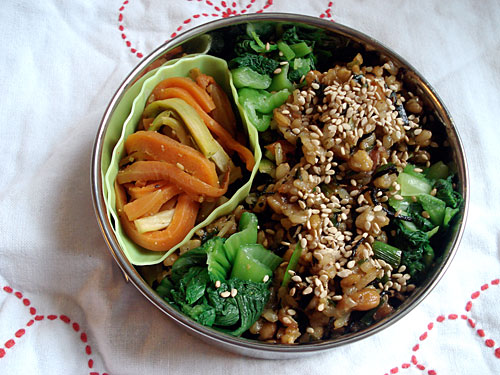Bento no. 59: Vegan Fried Rice Bento, Somewhat Macrobiotic
Bento contents:

- 1 1/2 cups (approx.) <a http://justbento.com/handbook/recipe-collection-mains/natto-or-tempeh-fried-rice">Natto Fried Rice with gomashio, 340 cal
- About 1/2 cup Carrot and broccoli stalk kinpira using the Forgotten Kinpira method, 40 cal
- About 1/2 cup blanched chard, 10 cal
Total calories (approx): 390 (how calories are calculated)
Time needed: 10-15 minutes in the morning
Type: Vegan, Japanese, rather macrobiotic
This bento, which is from Monday, is a quick-assemble vegan bento. I've already given the recipe for the main component, <a http://justbento.com/handbook/recipe-collection-mains/natto-or-tempeh-fried-rice">Natto Fried Rice, and of course the kinpira is a perennial favorite here. The crunchy texture and spicy flavor of the kinpira is a nice contrast to the rich, almost cheesy flavor of the rice. The rice was made from scratch (well, using frozen brown rice stash and some pre-made hijiki), and the kinpira was made last Friday, and I just briefly crisped it up a bit in a dry frying pan before cooling again and packing into the bento.
I thought it might be interesting to look at how this bento meets most macrobiotic (commonly abbreviated to 'makurobi' in Japan) guidelines. I am a bit skeptical about macrobiotics when it gets extreme, but I think it has some good ideas. So I pick and choose what makes sense to me and ignore the silly bits. Anyway, this bento does conform to a lot of macrobiotic rules:
- The main ingredient in brown rice. Brown rice is considered to be the most complete and well-balanced food according to macrobiotic thinking.
- It uses whole soybeans as opposed to tofu or soy milk. Tofu and soy milk are considered to be somewhat 'cooling' or 'yang', but whole beans are well balanced.
- I used homemade gomashio using a grey sea salt. Both sesame seeds and natural sea salt are much favored in macrobiotics.
- The carrot in the kinpira is not peeled (it's an organic carrot); macrobiotic theory goes that you should consume the whole vegetable to get all its energy. I also used the whole green onion, from tip to tail, and even chopped up the hairy roots (very well washed). As for the broccoli...I did eat the florets previously, so I guess I'm good there.
- Hijiki is also considered a well balanced food.
- No sugar or alcohol are used - both considered to be extreme 'yin' or 'cool' and unbalancing foods.
- Good monounsaturated oils are used for cooking (olive oil and sesame oil); these are considered to be well-balanced.
Now, I do have some spice in the kinpira - macrobiotics generally doesn't like spicy foods, which are considered to be too 'yang' or 'hot'. But hey - like I said, I pick and choose from the general macrobiotic canon to suit me, when I want to.
An a practical level, I've used a fairly small (capacity 400ml) round bento box for this, since a whole grain one-'dish' item like the fried rice is quite calorie dense and easy to overpack. I used the bento box for Bento 50, which featured a quinoa salad.
And speaking of quinoa, Clotilde of Chocolate and Zucchini has recently posted a very tasty sounding quinoa recipe. Japanese cuisine is spreading like a spilt bottle of soy sauce all over! :)
If you enjoyed this article, please consider supporting this site by becoming my patron via Patreon.
